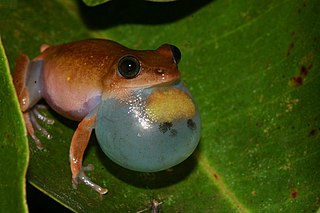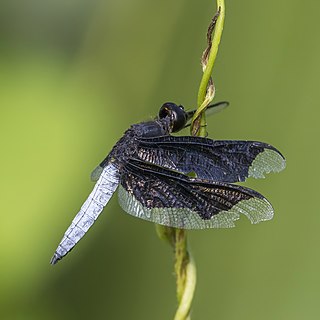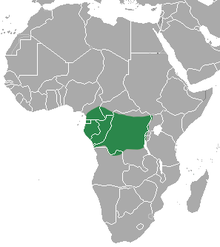
Aonyx is a genus of otters, containing three species, the African clawless otter, the Congo clawless otter, and the Asian small-clawed otter. The word aonyx means "clawless", derived from the prefix a- ("without") and onyx ("claw/hoof").

The African clawless otter, also known as the Cape clawless otter or groot otter, is the second-largest freshwater otter species. It inhabits permanent water bodies in savannah and lowland forest areas through most of sub-Saharan Africa. It is characterised by partly webbed and clawless feet, from which their name is derived. The word 'aonyx' means clawless, derived from the prefix a- ("without") and onyx ("claw/hoof").

Sclerophrys maculata — commonly known as Hallowell's toad, the flat-backed toad, and the striped toad — is an African member of Bufonidae, the true toad family.
Cryptothylax greshoffii is a species of frogs in the family Hyperoliidae. It is found in Angola, Cameroon, the Central African Republic, the Democratic Republic of the Congo, Equatorial Guinea, Gabon, and possibly Republic of the Congo. Its natural habitats are subtropical or tropical moist lowland forests, subtropical or tropical moist shrubland, rivers, swamps, freshwater lakes, freshwater marshes, intermittent freshwater marshes, rural gardens, heavily degraded former forests, and aquaculture ponds. Cryptothylax greshoffii and “Hyperolius” robustus have a phylogenetic relatationship

Hyperolius cinnamomeoventris is a species of frog in the family Hyperoliidae. It is found in Angola, Cameroon, Republic of the Congo, Democratic Republic of the Congo, Equatorial Guinea, Gabon, Ghana, Kenya, Uganda, Zambia, and possibly in Central African Republic, Rwanda, Sudan, and Tanzania. Its natural habitats are subtropical or tropical moist lowland forests, subtropical or tropical swamps, subtropical or tropical moist montane forests, dry savanna, moist savanna, subtropical or tropical seasonally wet or flooded lowland grassland, swamps, freshwater lakes, intermittent freshwater lakes, freshwater marshes, intermittent freshwater marshes, rural gardens, heavily degraded former forest, and ponds.

Hyperolius phantasticus is a species of frog in the family Hyperoliidae. It is found in Cameroon, Central African Republic, Republic of the Congo, Democratic Republic of the Congo, Gabon, possibly Angola, and possibly Equatorial Guinea. Its natural habitats are subtropical or tropical moist lowland forests, subtropical or tropical seasonally wet or flooded lowland grassland, freshwater marshes, intermittent freshwater marshes, rural gardens, heavily degraded former forest, and ponds.

Hyperolius platyceps is a species of frog in the family Hyperoliidae. It is found in Angola, Cameroon, Central African Republic, Republic of the Congo, Democratic Republic of the Congo, Equatorial Guinea, and Gabon. Its natural habitats are subtropical or tropical moist lowland forests, subtropical or tropical swamps, rivers, shrub-dominated wetlands, swamps, freshwater marshes, intermittent freshwater marshes, rural gardens, heavily degraded former forest, and ponds.
The common forest tree frog is a species of frog in the family Arthroleptidae found in Angola, Cameroon, the Republic of the Congo, the Democratic Republic of the Congo, Equatorial Guinea, Gabon, Nigeria, and possibly the Central African Republic. Its natural habitats are subtropical or tropical moist lowland forest, subtropical or tropical moist montane forest, subtropical or tropical high-altitude grassland, rivers, intermittent freshwater marshes, and heavily degraded former forests.
The golden puddle frog is a species of frog in the family Phrynobatrachidae. It is found in Cameroon, Central African Republic, Republic of the Congo, Democratic Republic of the Congo, Equatorial Guinea, Gabon, Nigeria, Rwanda, Uganda, and possibly Angola. Its natural habitats are subtropical or tropical moist lowland forest, rivers, freshwater marshes, intermittent freshwater marshes, and heavily degraded former forest. It is threatened by habitat loss due to deforestation.

The Cameroon clawed frog is a species of frog in the family Pipidae found in Angola, Cameroon, the Central African Republic, the Republic of the Congo, the Democratic Republic of the Congo, Equatorial Guinea, Gabon, and possibly Sudan. Its natural habitats are subtropical or tropical moist lowland forests, freshwater marshes, intermittent freshwater marshes, heavily degraded former forest, and ponds. It is threatened by habitat loss.

Fraser's platanna is a species of frogs in the family Pipidae found in Angola, Cameroon, Central African Republic, Republic of the Congo, Democratic Republic of the Congo, Equatorial Guinea, Gabon, and possibly Rwanda.
Peters' platanna is a species of frog in the family Pipidae found in Angola, Botswana, the Republic of the Congo, the Democratic Republic of the Congo, Gabon, Namibia, Zambia, Zimbabwe, and possibly Tanzania. Its natural habitats are subtropical or tropical moist lowland forests, dry savanna, moist savanna, subtropical or tropical dry shrubland, subtropical or tropical moist shrubland, subtropical or tropical dry lowland grassland, subtropical or tropical seasonally wet or flooded lowland grassland, subtropical or tropical high-altitude grassland, rivers, intermittent rivers, swamps, freshwater lakes, intermittent freshwater lakes, freshwater marshes, intermittent freshwater marshes, freshwater springs, arable land, pastureland, rural gardens, urban areas, heavily degraded former forests, water storage areas, ponds, open excavations, and canals and ditches.

The crowned bullfrog is a species of frog in the family Dicroglossidae. It is found in the Sub-Saharan Africa . Its natural habitats are subtropical or tropical moist lowland forest, dry savanna, moist savanna, subtropical or tropical dry shrubland, subtropical or tropical moist shrubland, subtropical or tropical dry lowland grassland, subtropical or tropical seasonally wet or flooded lowland grassland, rivers, intermittent rivers, freshwater lakes, intermittent freshwater lakes, freshwater marshes, intermittent freshwater marshes, freshwater springs, arable land, pastureland, rural gardens, heavily degraded former forest, and ponds.
The Victoria ridged frog is a species of frog in the family Ptychadenidae. It is found in Benin, Cameroon, Central African Republic, Republic of the Congo, Democratic Republic of the Congo, Ivory Coast, Equatorial Guinea, Gabon, Ghana, Guinea, Liberia, Nigeria, possibly Angola, and possibly Togo. Its natural habitats are subtropical or tropical moist lowland forest, intermittent freshwater marshes, and heavily degraded former forest. It is threatened by habitat loss.
Agriocnemis maclachlani is a species of damselfly in the family Coenagrionidae. It is found in Cameroon, the Republic of the Congo, Ivory Coast, Equatorial Guinea, Gabon, Gambia, Ghana, Guinea, Liberia, Nigeria, Senegal, Sierra Leone, and Uganda. Its natural habitats are subtropical or tropical moist lowland forests, freshwater lakes, intermittent freshwater lakes, freshwater marshes, and intermittent freshwater marshes.

Orthetrum brachiale, the tough skimmer or strong skimmer, is a species of dragonfly in the family Libellulidae. It is found in Angola, Benin, Botswana, Burkina Faso, Cameroon, Central African Republic, Chad, Comoros, the Republic of the Congo, the Democratic Republic of the Congo, Ivory Coast, Egypt, Equatorial Guinea, Ethiopia, Gabon, Gambia, Ghana, Guinea, Kenya, Liberia, Madagascar, Malawi, Mali, Mauritania, Mauritius, Mozambique, Namibia, Niger, Nigeria, Réunion, Seychelles, Sierra Leone, Somalia, South Africa, Sudan, Tanzania, Togo, Uganda, Zambia, Zimbabwe, possibly Burundi, and possibly São Tomé and Príncipe. Its natural habitats are subtropical or tropical moist lowland forests, dry savanna, moist savanna, subtropical or tropical dry shrubland, subtropical or tropical moist shrubland, shrub-dominated wetlands, swamps, intermittent freshwater lakes, freshwater marshes, and intermittent freshwater marshes.

Palpopleura lucia, the Lucia widow, is a species of dragonfly in the family Libellulidae. It is found in Angola, Benin, Botswana, Burkina Faso, Cameroon, Central African Republic, Chad, Comoros, the Democratic Republic of the Congo, Ivory Coast, Equatorial Guinea, Ethiopia, Gabon, Gambia, Ghana, Guinea, Kenya, Liberia, Madagascar, Malawi, Mozambique, Namibia, Nigeria, São Tomé and Príncipe, Sierra Leone, Somalia, South Africa, Sudan, Tanzania, Togo, Uganda, Zambia, Zimbabwe, and possibly Burundi. Its natural habitats are subtropical or tropical moist lowland forests, subtropical or tropical dry shrubland, rivers, intermittent rivers, shrub-dominated wetlands, swamps, freshwater lakes, intermittent freshwater lakes, freshwater marshes, intermittent freshwater marshes, and freshwater springs.

Phyllomacromia melania is a species of dragonfly in the family Macromiidae. It is found in Angola, Cameroon, the Republic of the Congo, the Democratic Republic of the Congo, Equatorial Guinea, Gabon, Ghana, Guinea, Kenya, Liberia, Malawi, Nigeria, Sierra Leone, Tanzania, Uganda, possibly Botswana, possibly Burundi, possibly Ivory Coast, possibly Gambia, possibly Mali, possibly Mozambique, possibly Namibia, possibly Senegal, possibly South Africa, possibly Sudan, possibly Togo, possibly Zambia, and possibly Zimbabwe. Its natural habitats are subtropical or tropical moist lowland forests, rivers, intermittent freshwater lakes, and intermittent freshwater marshes.

Trithemis monardi is a species of dragonfly in the family Libellulidae. It is found in Angola, Benin, Botswana, Burkina Faso, Cameroon, Central African Republic, the Democratic Republic of the Congo, Ivory Coast, Ethiopia, Gabon, Gambia, Ghana, Kenya, Malawi, Mali, Mozambique, Namibia, Nigeria, Sierra Leone, Uganda, Zambia, and Zimbabwe. Its natural habitats are subtropical or tropical moist lowland forests, subtropical or tropical dry shrubland, subtropical or tropical moist shrubland, rivers, swamps, freshwater marshes, and intermittent freshwater marshes.

The Cape clawless otter is a subspecies of African clawless otter found in sub-Saharan Africa near permanent bodies of freshwater and along the seacoast. It is the largest of the Old World otters and the third largest otter after the giant otter and the sea otter.
















